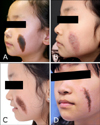1. Krengel S. Nevogenesis--new thoughts regarding a classical problem. Am J Dermatopathol. 2005; 27:456–465.

2. Kopf AW, Bart RS, Hennessey P. Congenital nevocytic nevi and malignant melanomas. J Am Acad Dermatol. 1979; 1:123–130.

3. Alikhan A, Ibrahimi OA, Eisen DB. Congenital melanocytic nevi: where are we now? Part I. Clinical presentation, epidemiology, pathogenesis, histology, malignant transformation, and neurocutaneous melanosis. J Am Acad Dermatol. 2012; 67:495.e1–495.e17.
4. Ibrahimi OA, Alikhan A, Eisen DB. Congenital melanocytic nevi: where are we now? Part II. Treatment options and approach to treatment. J Am Acad Dermatol. 2012; 67:515.e1–515.e13.
5. Marghoob AA, Agero AL, Benvenuto-Andrade C, Dusza SW. Large congenital melanocytic nevi, risk of cutaneous melanoma, and prophylactic surgery. J Am Acad Dermatol. 2006; 54:868–870.

6. Kinsler VA, Chong WK, Aylett SE, Atherton DJ. Complications of congenital melanocytic naevi in children: analysis of 16 years' experience and clinical practice. Br J Dermatol. 2008; 159:907–914.

7. Dawson HA, Atherton DJ, Mayou B. A prospective study of congenital melanocytic naevi: progress report and evaluation after 6 years. Br J Dermatol. 1996; 134:617–623.

8. Berg P, Lindelöf B. Congenital melanocytic naevi and cutaneous melanoma. Melanoma Res. 2003; 13:441–445.

9. Tannous ZS, Mihm MC Jr, Sober AJ, Duncan LM. Congenital melanocytic nevi: clinical and histopathologic features, risk of melanoma, and clinical management. J Am Acad Dermatol. 2005; 52:197–203.

10. Zaal LH, Mooi WJ, Klip H, van der Horst CM. Risk of malignant transformation of congenital melanocytic nevi: a retrospective nationwide study from The Netherlands. Plast Reconstr Surg. 2005; 116:1902–1909.

11. Al-Hadithy N, Al-Nakib K, Quaba A. Outcomes of 52 patients with congenital melanocytic naevi treated with UltraPulse Carbon Dioxide and Frequency Doubled Q-Switched Nd-Yag laser. J Plast Reconstr Aesthet Surg. 2012; 65:1019–1028.

12. Lee JM, Kim IH, Rhyu IJ, Ryu HJ. Combined intense pulsed light and Er:YAG laser treatment of congenital melanocytic nevus. J Cosmet Laser Ther. 2015; 17:162–164.

13. Moreno-Arias GA, Ferrando J. Noncoherent-intense-pulsed light for the treatment of relapsing hairy intradermal melanocytic nevus after shave excision. Lasers Surg Med. 2001; 29:142–144.

14. Minakawa S, Takeda H, Korekawa A, Kaneko T, Urushidate S, Sawamura D. Q-switched ruby laser therapy and longterm follow-up evaluation of small to medium-sized congenital melanocytic naevi. Clin Exp Dermatol. 2012; 37:438–440.

15. Lee SE, Choi JY, Hong KT, Lee KR. Treatment of acquired and small congenital melanocytic nevi with combined Er: YAG laser and long-pulsed alexandrite laser in Asian skin. Dermatol Surg. 2015; 41:473–480.

16. Arora H, Falto-Aizpurua L, Chacon A, Griffith RD, Nouri K. Lasers for nevi: a review. Lasers Med Sci. 2015; 30:1991–2001.

17. Moreno Arias GA, Ferrando J. Intense pulsed light for melanocytic lesions. Dermatol Surg. 2001; 27:397–400.

18. Martín JM, Monteagudo C, Bella R, Reig I, Jordá E. Complete regression of a melanocytic nevus under intense pulsed light therapy for axillary hair removal in a cosmetic center. Dermatology. 2012; 224:193–197.

19. Raulin C, Hellwig S, Schönermark MP. Treatment of a nonresponding port-wine stain with a new pulsed light source (PhotoDerm VL). Lasers Surg Med. 1997; 21:203–208.

20. Weiss RA, Weiss MA, Marwaha S, Harrington AC. Hair removal with a non-coherent filtered flashlamp intense pulsed light source. Lasers Surg Med. 1999; 24:128–132.

21. Kawada A, Shiraishi H, Asai M, Kameyama H, Sangen Y, Aragane Y, et al. Clinical improvement of solar lentigines and ephelides with an intense pulsed light source. Dermatol Surg. 2002; 28:504–508.

22. Goldberg DJ. Current trends in intense pulsed light. J Clin Aesthet Dermatol. 2012; 5:45–53.
23. Kilmer SL, Lee MS, Grevelink JM, Flotte TJ, Anderson RR. The Q-switched Nd:YAG laser effectively treats tattoos. A controlled, dose-response study. Arch Dermatol. 1993; 129:971–978.

24. Bjerring P, Christiansen K. Intense pulsed light source for treatment of small melanocytic nevi and solar lentigines. J Cutan Laser Ther. 2000; 2:177–181.

25. Anderson RR, Parrish JA. Selective photothermolysis: precise microsurgery by selective absorption of pulsed radiation. Science. 1983; 220:524–527.















 PDF
PDF ePub
ePub Citation
Citation Print
Print


 XML Download
XML Download